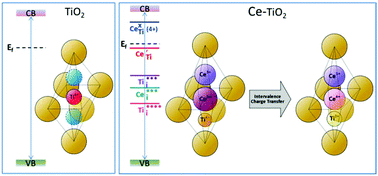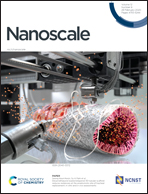Band gap engineering of Ce-doped anatase TiO2 through solid solubility mechanisms and new defect equilibria formalism†
Abstract
The present work reports a detailed mechanistic interpretation of the role of the solubility of dopants and resultant midgap defect energies in band gap engineering. While there is a general perception that a single dopant is associated with single solubility and defect mechanisms, in reality, the potential for multiple solubility and defect mechanisms requires a more nuanced interpretation. Similarly, Kröger–Vink defect equilibria assume that stoichiometries during substitutional and interstitial solid solubility as well as Schottky and Frenkel pair formation are compensated by the diffusion of matrix ions to the grain boundaries or surface. However, this approach does not allow the possibility that stoichiometry is uncompensated, where diffusion of the matrix ion to lattice interstices occurs, followed by charge compensation by redox of this ion. Consequently, a modified defect equilibria formalism has been developed in order to allow description of this situation. Experimental data for the structural, chemical, semiconducting, and photocatalytic properties as a function of doping level are correlated with conceptual structural models, a comprehensive energy band diagram, and the corresponding defect equilibria. These correlations reveal the complex mechanisms of the interrelated solubility and defect formation mechanisms, which change significantly and irregularly as a function of small changes in doping level. The analyses confirm that the assumption of single mechanisms of solid solubility and defect formation may be simplifications of more complex processes. The generation of (1) a matrix of complementary characterisation and analytical data, (2) the calculation of a complete energy band diagram, (3) consideration of charge compensation mechanisms and redox beyond the limitations of Kröger–Vink approaches, and (4) the development of models of corresponding structural analogies combine to create a new approach to interpret and explain experimental data. These strategies allow deconstruction of these complex issues and thus targeting of optimal and possibly unique doping levels to achieve lattice configurations that may be energetically and structurally unfavorable. These approaches then can be applied to other doped semiconducting systems.



 Please wait while we load your content...
Please wait while we load your content...